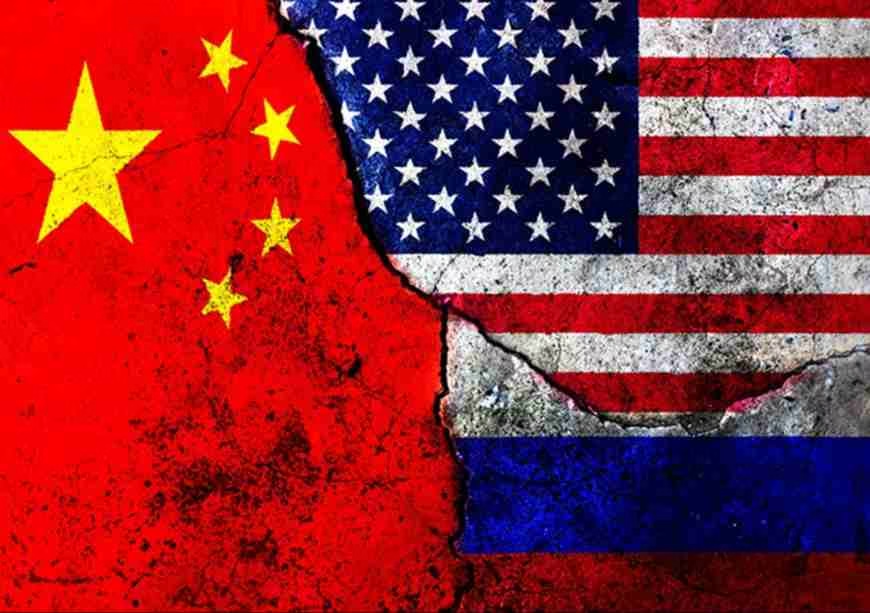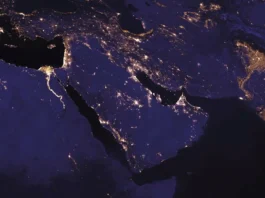Introduction: A New Era of Global Tension
When the Cold War ended in 1991 with the collapse of the Soviet Union, many believed the world had entered a new age of cooperation and peace. For a time, it seemed true: globalization surged, new alliances formed, and technological advancements connected humanity like never before. But beneath the surface, old patterns quietly simmered and today, it’s clear: a Cold War 2.0 is upon us.
From Washington to Beijing, from Moscow to Brussels, global powers are drawing lines once again. Ideologies, economic rivalries, military posturing all signs suggest that we are re-entering a familiar, dangerous game, with new players and higher stakes. This new cold war between US and China represents the most significant geopolitical shift since the fall of the Berlin Wall, fundamentally reshaping international relations and global power dynamics.
The emergence of Cold War 2.0 isn’t merely a return to the past it’s a complex evolution of great power competition adapted to the realities of the 21st century. Unlike its predecessor, this new era of rivalry encompasses multiple dimensions: technological supremacy, economic warfare, information battles, and the struggle for influence in an increasingly multipolar world.
The New Divisions: More Than East vs West
Unlike the original Cold War, which was primarily a standoff between the United States and the Soviet Union, the current landscape is multipolar. The United States faces challenges not only from Russia but from an even more formidable economic and technological competitor: China. Meanwhile, regional powers like India, Iran, Turkey, and others assert their influence, making the global chessboard more complex than ever.

This multipolar world order represents a fundamental shift from the unipolar moment that characterized the immediate post-Cold War era. The rise of China as an economic superpower, Russia’s resurgence under Vladimir Putin, and the emergence of middle powers seeking greater autonomy have created a more fragmented and competitive international system.
Instead of a simple ideological divide (capitalism vs. communism), today’s competition involves:
- Technology supremacy (5G, AI, cybersecurity, quantum computing)
- Resource control (energy, rare earth minerals, water, critical supply chains)
- Narrative dominance (media, influence campaigns, soft power projection)
- Economic models (state capitalism vs. free-market liberalism)
- Digital sovereignty (data governance, internet infrastructure, digital currencies)
The Cold War 2.0 is not just about tanks and missiles. It’s about data, chips, currency wars, and digital influence. This technology competition in new cold war has become the defining characteristic of contemporary great power rivalry, with nations recognizing that technological leadership translates directly into economic prosperity and military advantage.
Key Players and Alliances Emerging
The United States leads the Western bloc, backed by traditional allies like Europe, Japan, Australia, and South Korea. However, maintaining this coalition requires constant diplomatic effort as allies sometimes have divergent interests, particularly regarding economic relations with China.
China and Russia present a growing counterweight, forming strategic partnerships that extend into military exercises, trade deals, and diplomatic support. The China-Russia strategic partnership has deepened significantly since 2014, with both nations finding common ground in their opposition to Western-led international institutions and their desire to reshape the global order.

New blocs are forming that reflect the multipolar geopolitics of our era:
- BRICS Expansion: Brazil, Russia, India, China, South Africa with recent discussions of adding countries like Saudi Arabia, Iran, Egypt, and the UAE. This expansion represents an attempt to create an alternative power center to Western-dominated institutions.
- AUKUS Pact: A trilateral security pact between Australia, the United Kingdom, and the United States aimed at countering China’s growing naval power in the Indo-Pacific region.
- Belt and Road Initiative: China’s sprawling infrastructure investment project, gaining influence in Asia, Africa, and Europe while creating new dependencies and spheres of influence.
- Shanghai Cooperation Organization (SCO): A Eurasian political, economic, and security alliance that includes China, Russia, and several Central Asian states, representing an alternative to Western-led security arrangements.
The alliances are less ideological than before, but the competition for global leadership is unmistakably fierce. These new cold war alliances are often based on pragmatic considerations rather than shared values, making them potentially more flexible but also less predictable than their Cold War predecessors.
Technology as the New Battlefield
In the Cold War of the 20th century, nuclear arms were the ultimate weapon. In Cold War 2.0, technology is the battlefield. The artificial intelligence arms race between the United States and China has become a central feature of contemporary great power competition, with both nations recognizing that AI leadership will determine future economic and military dominance.

Semiconductors are the new oil, with the semiconductor cold war reshaping global supply chains and forcing nations to choose sides.
- Artificial Intelligence is the new arms race, with massive investments in AI research and development.
- Cyberwarfare replaces traditional espionage, with state-sponsored hacking groups conducting operations across borders.
- Quantum computing promises to revolutionize encryption and computing power.
- Space technology has become a new domain of competition, with military and commercial implications.
Control over these domains not only offers economic superiority but strategic dominance. The US China tech war has intensified dramatically since 2018, with both nations implementing export controls, investment restrictions, and technology transfer limitations.
Recent examples of technological competition:
- The U.S. restricting China’s access to advanced microchips through export controls and sanctions on Chinese tech companies.
- China accelerating investment in quantum computing, 6G technology, and domestic semiconductor production.
- Russia’s emphasis on cyber operations to influence elections and destabilize adversaries.
- The race to develop hypersonic weapons and advanced missile defense systems.
- Competition in space technology, including satellite networks and space-based military capabilities.
The battle for technological leadership could define the next 50 years. Nations that fall behind in critical technologies risk becoming dependent on their competitors, creating vulnerabilities that could be exploited in times of crisis.
Economic Pressures and Trade Wars
The first Cold War was defined by military spending; this one is also a trade and economic war. The economic competition in Cold War 2.0 has become increasingly sophisticated, involving not just tariffs and sanctions but complex financial instruments and supply chain manipulation.

Sanctions, tariffs, and protectionist policies are replacing tanks on the frontlines. The decoupling of U.S. and Chinese economies particularly in critical sectors like tech, energy, and finance is reshaping global trade patterns and forcing other nations to choose sides or navigate carefully between competing powers.
Key economic battlegrounds include:
- De-dollarization efforts are growing, with countries seeking alternatives to U.S.-dominated financial systems through digital currencies and alternative payment systems.
- Energy alliances are shifting, especially as Europe reduces dependence on Russian gas following the Ukraine conflict.
- Supply chain resilience has become a national security priority, with nations seeking to reduce dependencies on potential adversaries.
- Critical mineral access has become a strategic concern, with China controlling much of the rare earth supply chain.
Economic interdependence, once seen as a safeguard against conflict, is now a double-edged sword: vulnerability rather than stability. The global economic rivalry has created a more fragmented world economy, with parallel systems emerging to serve different blocs of nations.
Information Warfare and Digital Influence
One of the most significant differences between the original Cold War and Cold War 2.0 is the role of information warfare and digital influence operations. The internet and social media have created new battlegrounds for hearts and minds, with state and non-state actors using sophisticated techniques to shape public opinion and political outcomes.

Digital influence campaigns have become a standard tool of statecraft, with nations investing heavily in:
- Social media manipulation to influence foreign elections and public opinion
- Disinformation campaigns designed to undermine trust in democratic institutions
- Cyber espionage to steal intellectual property and state secrets
- Digital infrastructure control through telecommunications and internet governance
The information war in Cold War 2.0 operates at unprecedented speed and scale, with the potential to influence millions of people simultaneously. Unlike traditional propaganda, modern information warfare can be precisely targeted and continuously adapted based on real-time feedback.
Proxy Conflicts and the Risk of Escalation
Another chilling similarity with the first Cold War: proxy conflicts. Rather than direct war between major powers, smaller nations become battlegrounds where great powers compete for influence and test their capabilities.

RaCurrent and potential proxy conflicts include:
- Ukraine war, backed by Western powers against Russian aggression, representing the most significant European conflict since World War II.
- Rising tensions over Taiwan, drawing U.S. and Chinese forces into a delicate, dangerous standoff that could trigger a broader conflict.
- Ongoing instability in Africa and the Middle East, where global powers compete for influence through local conflicts and resource extraction.
- Cyber proxy warfare, where state-sponsored hacking groups conduct operations with plausible deniability.
Each flashpoint carries the risk of escalation into a broader confrontation just as Korea, Vietnam, and Afghanistan did in the 20th century. The proxy wars in new cold war are complicated by the interconnected nature of the modern world, where local conflicts can have global economic and political ramifications.
Climate Change as a Complicating Factor
Unlike the original Cold War, Cold War 2.0 is unfolding against the backdrop of climate change, which adds new dimensions to great power competition. Climate change affects geopolitical competition in several ways:
- Resource scarcity creates new sources of conflict and competition
- Climate migration can destabilize regions and create humanitarian crises
- Green technology competition has become a new arena for technological rivalry
- Arctic competition has intensified as ice melts open new shipping routes and resource extraction opportunities
The climate dimension of Cold War 2.0 means that environmental policies have become geopolitical tools, with nations using climate commitments and green technology exports to gain influence and competitive advantages.
The Role of Middle Powers
One significant difference from the original Cold War is the increased importance of middle powers in shaping global outcomes. Countries like India, Brazil, Turkey, Saudi Arabia, and others are pursuing more independent foreign policies, refusing to align completely with either major bloc.
These middle powers in multipolar world are:
- Maintaining strategic autonomy while engaging with multiple great powers
- Leveraging their positions to extract concessions from competing blocs
- Creating alternative institutions and partnerships that bypass traditional power structures
- Playing balancing roles that can either stabilize or destabilize regional situations
The rise of middle powers makes the current international system more complex and unpredictable than the bipolar Cold War era.
Cold War 2.0: Why This Time Could Be Worse
Today’s interconnected world raises the stakes much higher than before. Several factors make Cold War 2.0 potentially more dangerous than its predecessor:
- Information travels instantly. A miscalculation or provocation can escalate in real time through social media and 24-hour news cycles.
- Global supply chains are fragile. A conflict could cripple economies overnight, affecting everything from food security to medical supplies.
- Environmental crises from climate change to pandemics could compound instability, pushing rival nations into more desperate, aggressive policies.
- Nuclear proliferation has continued, with more nations possessing nuclear weapons than during the original Cold War.
- Cyber vulnerabilities create new attack vectors that could cripple critical infrastructure without traditional military action.
In short, Cold War 2.0 isn’t happening in a vacuum. It’s layered atop other global challenges, making its consequences potentially even more catastrophic. The risks of new cold war are amplified by the complexity and interconnectedness of modern society.
Conclusion: Will We Learn from History?
The first Cold War ended without a direct superpower war a historical miracle given the tensions. Will humanity be so lucky this time?
If there’s a lesson from history, it’s that competition without dialogue leads to disaster. Rivalry is inevitable; conflict is not but avoiding it requires wisdom, patience, and above all, understanding that victory through domination leads only to mutual ruin.
Cold War 2.0 is here. The question now is: can we manage it better than the first? The answer will depend on whether world leaders can find ways to compete without destroying the foundations of international cooperation that have prevented global catastrophe for over seven decades.
The future of Cold War 2.0 will be determined by choices made today. Unlike the original Cold War, which was primarily a bilateral competition, the current era requires managing multiple competing powers, technological disruption, climate change, and global interconnectedness simultaneously. Success will require new forms of diplomacy, international cooperation, and crisis management that go beyond the tools used in the 20th century.
The stakes could not be higher. In an age of nuclear weapons, cyber warfare, and global supply chains, the cost of miscalculation has never been greater. Yet history also shows that even the most intense rivalries can be managed through careful diplomacy, mutual understanding, and recognition of shared interests in avoiding catastrophic conflict.
Cold War 2.0 is here. The question now is: can we manage it better than the first?




